Maha Shivaratri (Great Night of Shiva) celebrations start on the 13th evening of Phalgun, continuing into the 14th. Different from other festivals, it starts after sundown and goes through the night into the next day. Fasting, introspection and vigilance mark its celebrations rather than feasting and joyous merrymaking typical of other festivals. Maha Shivarati marks a solemn remembrance of “overcoming darkness and ignorance” in life and the world. The ardent devotees keep an all night vigil.
Maha Shivaratri & Churning of the Ocean
Mythology provides several reasons for Maha Shivaratri. Some say that on this particular day Lord Shiva gulped the Halahala poison produced during Samudra manthan (churning of the ocean), holding it in his neck. This bruised and turned his neck blue, giving him the name Neel Kanth. The Bhagavata Purana, Mahabharata and Vishnu Purana narrate this saga, also explaining the origin of Amrita, the nectar of immortality. The story goes that the devas and asuras, making a temporary alliance, churned the ocean to retrieve this nectar of immortality. To churn the ocean they used Mount Mandara as a churning rod. They used Vasuki, a nāgarāja snake abiding on Shiva’s neck, as the churning rope.
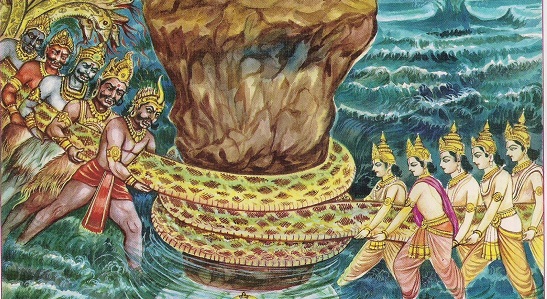
In the back-and-forth churning of the ocean, the serpent Vasuki released a deadly poison so powerful that it would have destroyed not only all those churning the ocean, but all the worlds as well. To save them Shiva held the poison in his mouth and this turned his throat blue. In some versions Lord Shiva swallowed the poison and suffered intense pain as it entered his body. For this reason, devotees mark this occasion with fasting, in a somber and introspective manner.
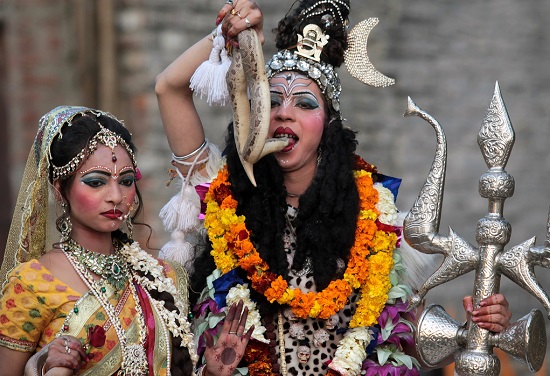
The Samudra Manthan Story and Maha Shivaratri which celebrates it, gives context to what Jesus did on Day 6 of Passion Week, so we can appreciate its meaning.
Jesus and the Figurative Churning of the Ocean
When Jesus entered Jerusalem on Day 1 he stood atop Mount Moriah, where 2000 years earlier Abraham had prophesied that a great sacrifice ‘will be’ (future tense) provided. Then Jesus declared:
Now is the time for judgment on this world; now the prince of this world will be driven out
John 12:31
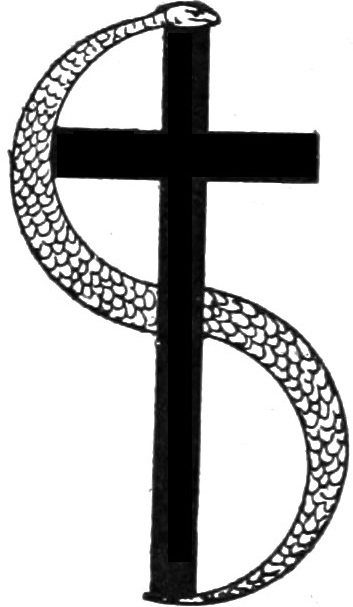
The ‘world’ would revolve around the struggle about to take place on that Mountain, between him and Satan, the ‘prince of this world’, often depicted as a serpent. Figuratively speaking, Mount Moriah was Mount Mandara, the turning rod, which would churn the whole world in the ensuing battle.
The serpent (nagaraja) Satan had entered Judas on Day 5 to strike Christ. As Vasuki became a churning rope, Satan would, figuratively speaking, become the churning rope around Mount Moriah as the battle between these two neared its climax.
The Last Supper
Next evening Jesus shared his last supper with his disciples. This was the 13th evening of the month, as Maha Shivaratri begins on the 13th. At that meal Jesus shared about the ‘cup’ he was going to drink, similar to Shiva drinking Vasuki’s poison. Here is that discourse.
27 Then he took a cup, and when he had given thanks, he gave it to them, saying, “Drink from it, all of you. 28 This is my blood of the covenant, which is poured out for many for the forgiveness of sins.
Matthew 26: 27-28
Then he explained through example and teaching how to love one another and about God’s great love for us, recorded here from the Gospel. Afterwards, he prayed for all believers (read here).
In the Garden of Gethsemene
Then, as in Maha Sivaratri, he began his all-night vigil in the Garden
Then Jesus went with his disciples to a place called Gethsemane, and he said to them, “Sit here while I go over there and pray.” 37 He took Peter and the two sons of Zebedee along with him, and he began to be sorrowful and troubled. 38 Then he said to them, “My soul is overwhelmed with sorrow to the point of death. Stay here and keep watch with me.”
39 Going a little farther, he fell with his face to the ground and prayed, “My Father, if it is possible, may this cup be taken from me. Yet not as I will, but as you will.”
40 Then he returned to his disciples and found them sleeping. “Couldn’t you men keep watch with me for one hour?” he asked Peter. 41 “Watch and pray so that you will not fall into temptation. The spirit is willing, but the flesh is weak.”
42 He went away a second time and prayed, “My Father, if it is not possible for this cup to be taken away unless I drink it, may your will be done.”
43 When he came back, he again found them sleeping, because their eyes were heavy. 44 So he left them and went away once more and prayed the third time, saying the same thing.
45 Then he returned to the disciples and said to them, “Are you still sleeping and resting? Look, the hour has come, and the Son of Man is delivered into the hands of sinners. 46 Rise! Let us go! Here comes my betrayer!”
Matthew 26:36-46
The disciples could not stay awake and the vigil had just begun! The Gospel then describes how Judas betrayed him.
The arrest in the Garden
2 Now Judas, who betrayed him, knew the place, because Jesus had often met there with his disciples. 3 So Judas came to the garden, guiding a detachment of soldiers and some officials from the chief priests and the Pharisees. They were carrying torches, lanterns and weapons.
4 Jesus, knowing all that was going to happen to him, went out and asked them, “Who is it you want?”
5 “Jesus of Nazareth,” they replied.
“I am he,” Jesus said. (And Judas the traitor was standing there with them.) 6 When Jesus said, “I am he,” they drew back and fell to the ground.
7 Again he asked them, “Who is it you want?”
“Jesus of Nazareth,” they said.
8 Jesus answered, “I told you that I am he. If you are looking for me, then let these men go.” 9 This happened so that the words he had spoken would be fulfilled: “I have not lost one of those you gave me.”
10 Then Simon Peter, who had a sword, drew it and struck the high priest’s servant, cutting off his right ear. (The servant’s name was Malchus.)
11 Jesus commanded Peter, “Put your sword away! Shall I not drink the cup the Father has given me?”
12 Then the detachment of soldiers with its commander and the Jewish officials arrested Jesus. They bound him 13 and brought him first to Annas, who was the father-in-law of Caiaphas, the high priest that year.
John18:2-13
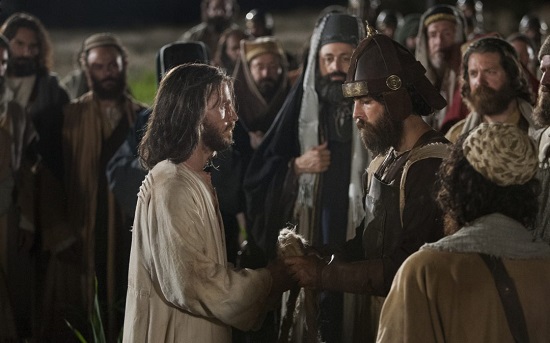
Jesus had gone to the garden to pray. There Judas brought soldiers to arrest him. If arrest threatens us we might try to fight, run or hide. But Jesus did none of these. He admitted that he was the person they were looking for. His clear confession (“I am he”) startled the soldiers so his disciples escaped. Jesus submitted to arrest and was taken for interrogation.
The First Interrogation
The Gospel records how they interrogated him:
Meanwhile, the high priest questioned Jesus about his disciples and his teaching.
20 “I have spoken openly to the world,” Jesus replied. “I always taught in synagogues or at the temple, where all the Jews come together. I said nothing in secret. 21 Why question me? Ask those who heard me. Surely they know what I said.”
22 When Jesus said this, one of the officials nearby slapped him in the face. “Is this the way you answer the high priest?” he demanded.
23 “If I said something wrong,” Jesus replied, “testify as to what is wrong. But if I spoke the truth, why did you strike me?” 24 Then Annas sent him bound to Caiaphas the high priest.
John18:19-24
So they sent Jesus to the high priest for a second interrogation.
The Second Interrogation
There they interrogated him in front of all the leaders. The Gospel recorded this second interrogation:
They took Jesus to the high priest, and all the chief priests, the elders and the teachers of the law came together. 54 Peter followed him at a distance, right into the courtyard of the high priest. There he sat with the guards and warmed himself at the fire.
55 The chief priests and the whole Sanhedrin were looking for evidence against Jesus so that they could put him to death, but they did not find any. 56 Many testified falsely against him, but their statements did not agree.
57 Then some stood up and gave this false testimony against him: 58 “We heard him say, ‘I will destroy this temple made with human hands and in three days will build another, not made with hands.’” 59 Yet even then their testimony did not agree.
60 Then the high priest stood up before them and asked Jesus, “Are you not going to answer? What is this testimony that these men are bringing against you?” 61 But Jesus remained silent and gave no answer.
Again the high priest asked him, “Are you the Messiah, the Son of the Blessed One?”
62 “I am,” said Jesus. “And you will see the Son of Man sitting at the right hand of the Mighty One and coming on the clouds of heaven.”
63 The high priest tore his clothes. “Why do we need any more witnesses?” he asked. 64 “You have heard the blasphemy. What do you think?”
They all condemned him as worthy of death. 65 Then some began to spit at him; they blindfolded him, struck him with their fists, and said, “Prophesy!” And the guards took him and beat him.
Mark14:53-65
The Jewish leaders condemned Jesus to death. But since Romans ruled them, only the Roman governor could approve an execution. So they took Jesus to the Roman Governor Pontius Pilate. The Gospel also records what happened to Judas Iscariot, Jesus’ betrayer.
What happened to Judas the betrayer?
Early in the morning, all the chief priests and the elders of the people made their plans how to have Jesus executed. 2 So they bound him, led him away and handed him over to Pilate the governor.
3 When Judas, who had betrayed him, saw that Jesus was condemned, he was seized with remorse and returned the thirty pieces of silver to the chief priests and the elders. 4 “I have sinned,” he said, “for I have betrayed innocent blood.”
“What is that to us?” they replied. “That’s your responsibility.”
5 So Judas threw the money into the temple and left. Then he went away and hanged himself.
Matthew 27: 1-5
Jesus interrogated by the Roman Governor
Meanwhile Jesus stood before the governor, and the governor asked him, “Are you the king of the Jews?”
“You have said so,” Jesus replied.
12 When he was accused by the chief priests and the elders, he gave no answer. 13 Then Pilate asked him, “Don’t you hear the testimony they are bringing against you?” 14 But Jesus made no reply, not even to a single charge—to the great amazement of the governor.
15 Now it was the governor’s custom at the festival to release a prisoner chosen by the crowd. 16 At that time they had a well-known prisoner whose name was Jesus Barabbas. 17 So when the crowd had gathered, Pilate asked them, “Which one do you want me to release to you: Jesus Barabbas, or Jesus who is called the Messiah?” 18 For he knew it was out of self-interest that they had handed Jesus over to him.
19 While Pilate was sitting on the judge’s seat, his wife sent him this message: “Don’t have anything to do with that innocent man, for I have suffered a great deal today in a dream because of him.”
20 But the chief priests and the elders persuaded the crowd to ask for Barabbas and to have Jesus executed.
21 “Which of the two do you want me to release to you?” asked the governor.
“Barabbas,” they answered.
22 “What shall I do, then, with Jesus who is called the Messiah?” Pilate asked.
They all answered, “Crucify him!”
23 “Why? What crime has he committed?” asked Pilate.
But they shouted all the louder, “Crucify him!”
24 When Pilate saw that he was getting nowhere, but that instead an uproar was starting, he took water and washed his hands in front of the crowd. “I am innocent of this man’s blood,” he said. “It is your responsibility!”
25 All the people answered, “His blood is on us and on our children!”
26 Then he released Barabbas to them. But he had Jesus flogged, and handed him over to be crucified.
Matthew27:11-26
The Crucifixion, Death & Burial of Jesus
The Gospel then records the details of Jesus’ crucifixion:
Then the governor’s soldiers took Jesus into the Praetorium and gathered the whole company of soldiers around him. 28 They stripped him and put a scarlet robe on him, 29 and then twisted together a crown of thorns and set it on his head. They put a staff in his right hand. Then they knelt in front of him and mocked him. “Hail, king of the Jews!” they said. 30 They spit on him, and took the staff and struck him on the head again and again. 31 After they had mocked him, they took off the robe and put his own clothes on him. Then they led him away to crucify him.
The Crucifixion of Jesus
32 As they were going out, they met a man from Cyrene, named Simon, and they forced him to carry the cross. 33 They came to a place called Golgotha (which means “the place of the skull”). 34 There they offered Jesus wine to drink, mixed with gall; but after tasting it, he refused to drink it. 35 When they had crucified him, they divided up his clothes by casting lots. 36 And sitting down, they kept watch over him there. 37 Above his head they placed the written charge against him: this is jesus, the king of the jews.
38 Two rebels were crucified with him, one on his right and one on his left. 39 Those who passed by hurled insults at him, shaking their heads 40 and saying, “You who are going to destroy the temple and build it in three days, save yourself! Come down from the cross, if you are the Son of God!” 41 In the same way the chief priests, the teachers of the law and the elders mocked him. 42 “He saved others,” they said, “but he can’t save himself! He’s the king of Israel! Let him come down now from the cross, and we will believe in him. 43 He trusts in God. Let God rescue him now if he wants him, for he said, ‘I am the Son of God.’” 44 In the same way the rebels who were crucified with him also heaped insults on him.
The Death of Jesus
45 From noon until three in the afternoon darkness came over all the land. 46 About three in the afternoon Jesus cried out in a loud voice, “Eli, Eli, lema sabachthani?” (which means “My God, my God, why have you forsaken me?”).
47 When some of those standing there heard this, they said, “He’s calling Elijah.”
48 Immediately one of them ran and got a sponge. He filled it with wine vinegar, put it on a staff, and offered it to Jesus to drink. 49 The rest said, “Now leave him alone. Let’s see if Elijah comes to save him.”
50 And when Jesus had cried out again in a loud voice, he gave up his spirit.
51 At that moment the curtain of the temple was torn in two from top to bottom. The earth shook, the rocks split 52 and the tombs broke open. The bodies of many holy people who had died were raised to life. 53 They came out of the tombs after Jesus’ resurrection and[e] went into the holy city and appeared to many people.
54 When the centurion and those with him who were guarding Jesus saw the earthquake and all that had happened, they were terrified, and exclaimed, “Surely he was the Son of God!”
Matthew27:27-54

‘Pierced’ in his side
The Gospel of John records a fascinating detail of the crucifixion. It states:
Now it was the day of Preparation, and the next day was to be a special Sabbath. Because the Jewish leaders did not want the bodies left on the crosses during the Sabbath, they asked Pilate to have the legs broken and the bodies taken down. 32 The soldiers therefore came and broke the legs of the first man who had been crucified with Jesus, and then those of the other. 33 But when they came to Jesus and found that he was already dead, they did not break his legs. 34 Instead, one of the soldiers pierced Jesus’ side with a spear, bringing a sudden flow of blood and water. 35 The man who saw it has given testimony, and his testimony is true. He knows that he tells the truth, and he testifies so that you also may believe.
John19:31-35
John saw the Roman soldiers pierce Jesus’ side with a spear. Out came blood and water separated, indicating that he died of heart failure.

Many also celebrate Maha Shivaratri because they consider it the day when Shiva married Parvati. Good Friday parallels Maha Sivaratri in that on that day Jesus also won his mystical bride, sealed by the spear in his side, explained further here.
Jesus’ Burial
The Gospel records the final event that day – his burial.
As evening approached, there came a rich man from Arimathea, named Joseph, who had himself become a disciple of Jesus. 58 Going to Pilate, he asked for Jesus’ body, and Pilate ordered that it be given to him. 59 Joseph took the body, wrapped it in a clean linen cloth, 60 and placed it in his own new tomb that he had cut out of the rock. He rolled a big stone in front of the entrance to the tomb and went away. 61 Mary Magdalene and the other Mary were sitting there opposite the tomb.
Matthew 27:57-61
Day 6 – Good Friday
Each day in the Jewish calendar began at sunset. So Day 6 began with Jesus sharing his last supper with his disciples. By the end of that day he had been arrested, put on trial many times throughout the night, crucified, pierced with a spear, and buried. It truly was ‘the Great Night of Jesus’. Pain, sorrow, humiliation and death marked this day and so people remember it in solemn contemplation as is Maha Shivaratri. But this day is called ‘Good Friday’. But how can a day of betrayal, torture and death ever be called ‘good’?
Why Good Friday and not ‘Bad Friday’?
As Shiva’s swallowing the serpent’s poison saved the world, so Jesus’ drinking his cup saved the world. It fell on Nisan 14, the same Passover day when the sacrificed lambs saved from death 1500 years before, showing it was planned.
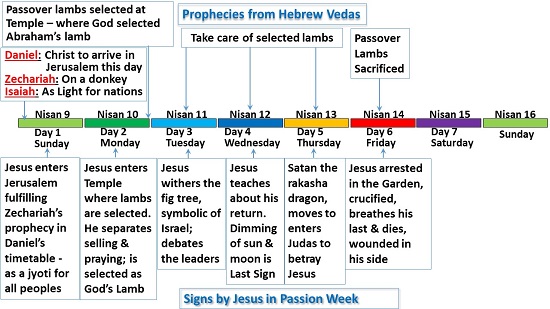
Accounts of men conclude with their deaths, but not Jesus. Next came the Sabbath – Day 7.